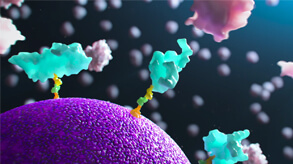Proteomic screening of stool samples for inflammatory bowel disease and colorectal cancer
Mounting evidence suggests that examining body fluids located near the point of pathology may yield improved biomarkers for disease detection, monitoring, and management. Efforts to further characterize the proteomes of various body fluids have been supported by using high-throughput proteomic platforms designed for sensitive and specific detection of proteins from complex sample matrices. Proteomic technology previously proven in plasma and serum screening has now been used in stool specimens to identify sensitive biomarkers for the detection and management of inflammatory bowel disease (IBD)1 and colorectal cancer (CRC).2Current clinical screening methods are insensitive, costly, and invasive, deterring patient compliance that is important for early detection and treatment. Discovering biomarkers from stool would improve patient compliance, improve accessibility in underserved populations, and significantly reduce morbidity and mortality rates associated with these conditions.
The case for new diagnostic tools for IBD and CRC
Current clinical screening for pediatric inflammatory bowel disease relies on the detection of elevated levels of fecal calprotectin, an indicator of neutrophil migration within the GI tract. Although this biomarker correlates well with endoscopy and histopathology, there are certain limitations to its utility. The sensitivity and specificity of fecal calprotectin is limited to the site of inflammation, having high specificity when inflammation is in the large bowel (as in ulcerative colitis or UC) as compared to when inflammation is located in the small bowel (as in Crohn’s disease or CD). Fecal calprotectin detection has also proven more accurate in an older patient population. As pediatric IBD can be a chronic, life-long condition treated with immunosuppressive therapies, diagnostic confirmation is required and often conducted using invasive endoscopy with tissue biopsy and histology.
Clinical detection of CRC relies on fecal occult blood testing (FOBT), fecal immunochemical testing (FIT), or colonoscopy. Limitations exist for each of these methods. FOBT requires follow-up testing due to high false-negative and -positive rates. Low sensitivity of FIT has been observed for advanced precancerous lesions. The most sensitive method, diagnostic colonoscopy, is invasive, requires patient bowel preparation and patient sedation, increases the risk of complication, and may miss precancerous lesions during examination. These screening tests also fall short of providing molecular characterization informing prognosis and treatment decisions.
Detection of sensitive biomarkers from stool offers a desirable alternative to existing or invasive screening methods. Stool specimens are easier to obtain than tissue or blood samples and are closer to the site of pathology. Stool can be tested as often as needed and at a low cost for sample collection. Several studies were recently conducted to evaluate the diagnostic and prognostic capabilities of stool biomarkers for the identification of IBD and CRC.
Proteomic studies discover new stool biomarkers of IBD and CRC
Studies were recently conducted to identify stool biomarkers to detect and manage pediatric IBD (Soomro, et al) and CRC (Li et al). Both studies examined stool samples collected from patient cohorts with active disease to obtain baseline and longitudinal measures of biomarkers that could be used as identifiers and predictors of clinical outcomes.
The IBD cohort samples were interrogated for 1,129 proteins, whereas the CRC cohort was screened for 1,317 proteins. The SomaScan® Assay, a novel aptamer-based high-throughput proteomic profiling tool from SomaLogic, was used to screen samples for 1,300 proteins simultaneously and with high sensitivity. Biomarkers identified in the screening assay were further validated using ELISA, and biomarkers from the CRC cohort were also validated based on CRC tissue databases. Many of these biomarkers have also been previously identified from disease-state blood samples.
Several important stool biomarkers for IBD outperformed fecal calprotectin, based on data from these high-throughput proteomic studies. Some biomarkers show promise in discriminating between diseased and healthy patients. Noteworthy among these are MMP-8, TIMP-2, fecal fibrinogen, and fecal PGRP-S. While further study is needed, these biomarkers may serve clinically useful as a screening test for pediatric IBD, assist in predicting disease progression, and enable monitoring response to drug therapy.
Several potentially important biomarkers were identified from proteomic screening of stool from CRC patients that might provide better clinical utility than FOBT for identification and prognosis. Of interest among these are MMP-9, fibrinogen, myeloperoxidase, and haptoglobin. Further evaluation of these biomarkers has the potential to improve screening tests for CRC and identify biomarkers capable of distinguishing between CRC, adenoma, and healthy patients. Tumor depth and invasion might also be indicated by measuring these proteins.
Both studies of the stool proteome indicate that biomarkers identified in stool specimens might improve detection of pediatric IBD and CRC and reduce the need for invasive diagnostic procedures. Some of the identified biomarkers might aid in differential diagnosis of clinically similar conditions for targeted treatment and management.
Proteomic aptamer-based technology key to large, continued studies
Further study is required to better ascertain the superiority of these or other biomarkers in the diagnosis and management of pediatric IBD and CRC, particularly within larger patient cohorts and as measured over time. New biomarkers capable of distinguishing UC from CD are needed.
To accomplish the goal of screening large numbers of samples for thousands of proteins, high-throughput proteomic studies will be key. An aptamer-based approach to proteomic profiling increases the number of targets that can be screened simultaneously, improving efficiency and reproducibility. Aptamer technology, which is at the core of the SomaScan Assay, is also capable of detecting low-abundance proteins within a complex sample matrix, making this tool optimal for surveying stool specimens. SomaScan Assay-based screening also compares favorably to mass spectrometry, which can be biased toward proteins in high abundance and makes discovery of low-concentration proteins challenging. The SomaScan Assay approach is validated, in that most biomarkers identified in the study have been found in blood or tumor tissues from these patient populations.
Potential for improved diagnostics using stool biomarkers
Currently used methods to detect pediatric IBD and CRC have proven inadequate, and the invasive screening techniques used lead to low patient compliance. For diagnostic screening procedures to be effective, the biomarkers used to identify and manage disease must be accurate, sensitive, and reliably detected, and screening methods must be tolerated by patients. The use of stool samples could improve patient compliance and allow for more frequent monitoring in high-risk populations leading to reduced morbidity and mortality in these diseases.
References
- Soomro, S. et al. Predicting disease course in ulcerative colitis using stool proteins identified through an aptamer-based screen. Nature Communications (2021) 12:3989 https://doi.org/10.1038/s41467-021-24235-0
- Li, H. et al. Comprehensive aptamer-based screen of 1317 proteins uncovers improved stool protein markers of colorectal cancer. J Gastroenterol (2021) 56:659-672. https://doi.org/10.1007/s00535-021-01795-y
More blogs
BlogHow Blood Proteomics Is Accelerating Neuro Drug Discovery
Explore how researchers are using blood-based proteomics – including data from the Global Neurodegeneration Proteomics Consortium (GNPC) – to uncover new protein signatures, genetic risk associations and mechanistic insights into aging and neurodegeneration.
BlogGNPC Neurodegeneration Proteomics Dataset
On July 15, 2025, the Global Neurodegeneration Proteomics Consortium (GNPC) published four open‑access papers unveiling the largest disease‑specific proteomic resource ever assembled.
BlogIndependent study validates the SomaScan Assay as the most precise and comprehensive plasma proteomic platform
A recent independent study by Alkahest, published as a preprint on bioRxiv1, compared the technical precision and performance of multiple plasma proteomic platforms using a common set of samples.





